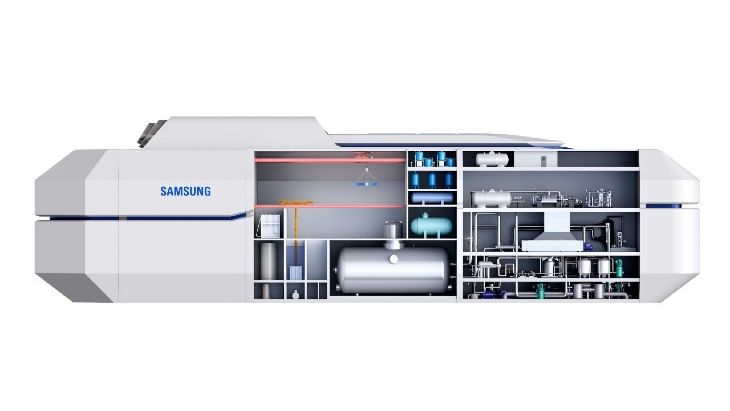Construction of China's first floating nuclear power plant has officially begun, China General Nuclear (CGN) announced. The demonstration unit is expected to be completed by 2020.
.jpg) |
| An artist's impression of how CGN's floating plant will look (Image: CGN) |
At a press conference in Shenzhen on 4 November, the company said it had signed the pressure vessel purchase agreement with Dongfang Electric for the demonstration ACPR50S offshore reactor.
China Guangdong Nuclear Power Research Institute deputy chief engineer and small reactor lead designer Rui Min said that, unlike the pouring of first safety concrete for a conventional land-based reactor, the signing of the vessel purchase agreement marks the official start of construction of the offshore unit. Of all the equipment necessary to construct the unit - including the floating platform - the vessel takes the longest to manufacture.
Development of the ACPR50S reactor design was approved by China's National Development and Reform Commission in late December 2015 as part of the 13th Five-Year Plan for innovative energy technologies.
The 200 MWt (60 MWe) reactor has been developed for the supply of electricity, heat and desalination and could be used on islands or in coastal areas, or for offshore oil and gas exploration, according to CGN.
CGN has completed both the conceptual and program design. The preliminary design work is expected to be completed soon.
The Chinese company is also working on the ACPR100 small reactor for use on land. That reactor will have an output of some 450 MWt (140 MWe) and would be suitable for providing power to large-scale industrial parks or to remote mountainous areas.
CGN said the development of small-scale offshore and onshore nuclear power reactors will complement its large-scale plants and provide more diverse energy options.
China National Nuclear Corporation also plans to build a demonstration floating nuclear power plant, based on its ACP100S small reactor, by 2019.
Russia is also building a floating nuclear power plant, featuring two 35 MWe KLT-40S reactors. The Akademik Lomonosov is currently undergoing trials at the Baltic Shipyard, which are expected to be completed by late October 2017. The plant should be ready to be transported to Pevek later that year. Rosenergoatom plans to start installation of the plant in September 2019, followed by trials and operational launch.
Floating plants offer various advantages: construction in a factory or shipyard should bring efficiencies; siting is simplified; environmental impact is extremely low; and decommissioning can take place at a specialised facility. However, the offshore environment brings important considerations, such as access for personnel and equipment and the need to ensure radioactive materials never enter the sea.
Researched and written
by World Nuclear News





_63865.jpg)
_18570.jpg)
_16159.jpg)





